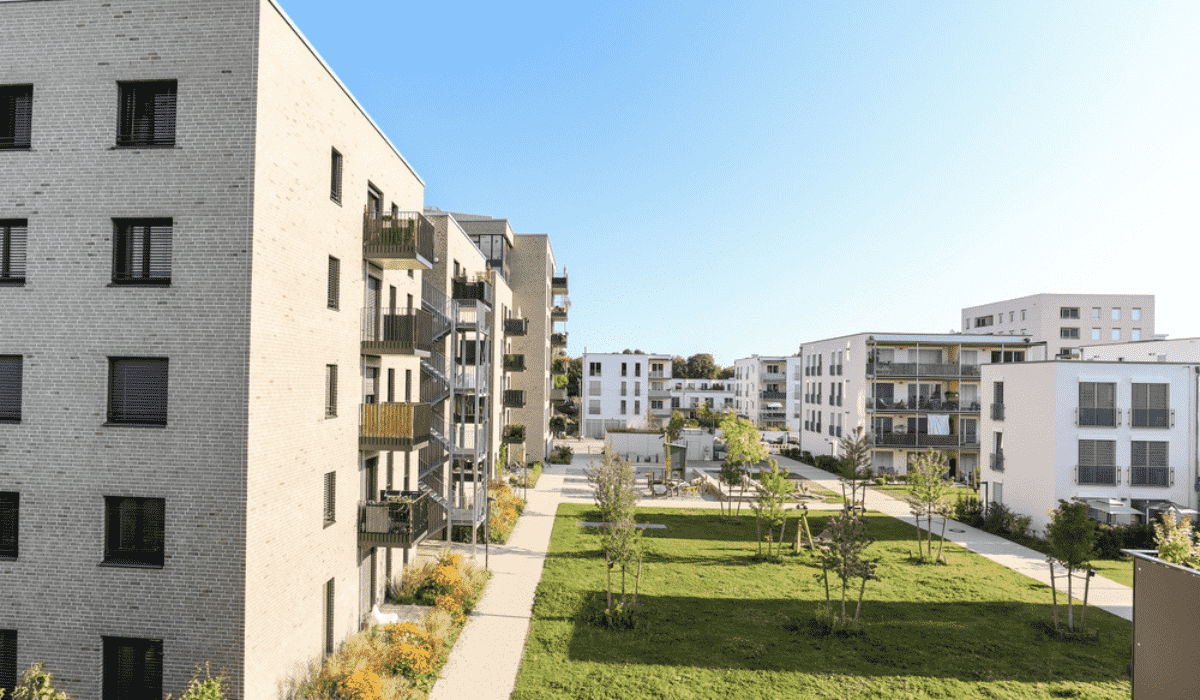The Indian real estate market offers a variety of housing options, from high-rise apartments to independent homes and low-rise apartments. Among these, low-rise apartments have gained popularity due to their unique blend of affordability, privacy, and community living. These buildings, typically two to four floors, offer a more intimate and serene living environment than high-rise towers. For homebuyers seeking a balanced lifestyle, low-rise apartments present a compelling choice. This article explores the advantages, challenges, and key factors before purchasing a house in a low-rise apartment in India.
Benefits of buying a house in a low-rise apartment
1. Enhanced privacy and lower density
Low-rise apartments house fewer residents, ensuring a more private and peaceful living environment. Unlike high-rise buildings with hundreds of units, these apartments limit the number of occupants, reducing noise and overcrowding.
2. Better ventilation and natural lighting
With fewer floors and open surroundings, low-rise apartments offer improved ventilation and ample natural light. Residents benefit from a healthier indoor environment, making these homes more comfortable and energy-efficient.
3. Lower maintenance costs
Maintenance charges in low-rise apartments are typically lower than in high-rise complexes. The absence of costly amenities like elevators, extensive security systems, and high-end clubhouses reduces homeowners’ monthly expenses.
4. More spacious layouts
Many low-rise apartments offer spacious floor plans compared to high-rise counterparts in the same price range. The availability of larger balconies, private terraces, and open spaces enhances the overall living experience.
5. Strong sense of community
With fewer units, residents in low-rise apartments tend to develop a stronger sense of community and neighbourly bonds. This fosters a friendly and cooperative environment, enhancing safety and social interaction.
6. Convenient access and ease of mobility
Living in a low-rise apartment eliminates the dependency on elevators, making daily movement easier, especially for elderly residents and children. The ease of access also proves beneficial in emergencies such as power outages or fire incidents.
7. Green surroundings and open spaces
Many low-rise developments focus on integrating green spaces and landscaped gardens, providing a serene environment. Unlike high-rise complexes that maximise vertical space, these apartments often include small parks, private gardens, or tree-lined pathways.
8. Potential for better resale value
Properties in low-rise apartments often appreciate well due to limited supply and higher demand for independent-style living. Buyers looking for a home with more privacy and exclusivity may be willing to pay a premium for such properties.
9. Lower seismic risks
In earthquake-prone regions of India, low-rise structures are generally considered safer due to their lower centre of gravity and structural stability. They are less susceptible to severe damage than high-rise buildings during seismic activities.
Fire safety in low-rise buildings
Low-rise apartments are generally safer during fire emergencies due to faster evacuation and direct stair access—there’s no dependency on lifts, and escape routes are shorter. However, this safety advantage only holds if the building complies with fire safety regulations.
In many Tier-2 and Tier-3 cities, smaller low-rise buildings may skip essential safety provisions such as fire extinguishers, hose reels, emergency lighting, or fire-resistant electrical wiring. Some may also lack a proper fire escape plan or signage.
Before buying, check if the project has received a Fire No Objection Certificate (NOC) from the local fire department. Ask the builder whether the structure follows the National Building Code (NBC) or state-specific fire norms. Inquire about smoke detectors, access for fire tenders, and emergency response protocols, especially if your apartment is on the upper floors.
How Low-Rise Apartments Compare with High-Rises and Independent Houses
| Parameter | Low-Rise Apartments | High-Rise Apartments | Independent Houses |
|---|---|---|---|
| Privacy | Moderate to high (fewer residents per building) | Low to moderate (shared walls, more units per floor) | Very high (no shared walls, full plot control) |
| Maintenance Costs | Lower (fewer shared amenities and services) | Higher (elevators, clubhouses, security, etc.) | Variable; often self-managed and can be high |
| Amenities | Basic (gardens, parking) | Extensive (pools, gyms, security, clubhouses) | Depends on owner; typically fewer unless custom-built |
| Construction Cost | Medium | Medium to high | High (due to land + structure cost) |
| Land Ownership | Moderate UDS (Undivided Share of Land) | Low UDS per unit | Full ownership of land |
| Resale Value | Good in well-connected areas; stable appreciation | Good in cities with high demand; resale may depend on tower age | High, especially in developed areas; land holds strong resale power |
| Customization | Limited (as per apartment design) | Very limited | High (owner can design/modify as needed) |
| Security | Basic or gated (varies by project) | Advanced, with CCTV, intercom, 24/7 security | Owner-managed or private; less standardized |
| Seismic Safety | Higher stability due to lower height | Moderate risk; subject to structural quality and codes | Depends on construction quality and layout |
| Availability in Metros | Limited; mainly in suburbs or low-density zones | High; primary format in urban areas | Very limited in central zones due to space and cost |
Challenges of buying a house in a low-rise apartment
1. Limited availability in metro cities
Low-rise apartments are more commonly found in suburban or semi-urban areas, making them less accessible in prime city locations. In metro cities, the emphasis is on high-rise development due to space constraints, limiting choices for buyers.
2. Fewer amenities
Low-rise apartments typically have fewer amenities than high-rise apartments with swimming pools, gyms, and clubhouses. Buyers prioritising modern lifestyle facilities may find such projects lacking in comparison.
3. Security concerns
Smaller buildings may not have advanced security systems, such as gated entrances, CCTV surveillance, or 24/7 security personnel. Homeowners might need to invest in additional security measures for peace of mind.
4. Potential parking limitations
Parking space can be a challenge in some low-rise apartment complexes. Unlike high-rise towers with designated parking levels, low-rise buildings may have limited on-site parking, requiring residents to rely on street parking or nearby facilities.
5. Fewer financing options
Since most low-rise developments are located in suburban areas, some banks may be hesitant to offer home loans compared to well-established high-rise projects. Buyers should ensure major financial institutions approve their preferred property before purchasing.
Where low-rise apartments are most common in India?
Low-rise formats (typically stilt + 3/4 floors, often called builder floors or walk-ups) cluster in older planned colonies, bungalow layouts, and suburban growth corridors. Knowing where they dominate helps set expectations on pricing, amenities, and buyer profile.
NCR
- Gurgaon: DLF Phases I–III, Sushant Lok, South City, New Gurgaon village-plot conversions (builder floors with private lift/terrace; luxury-spec options common). Target buyer: upper-mid to premium families wanting independent feel without a villa ticket size.
• South Delhi: GK, Hauz Khas, Defence Colony, Panchsheel—redeveloped plots with stilt + 3 floors; high land component, boutique amenities.
• Noida/Greater Noida: Sectors 19–27 (older co-op pockets), 41/50/51/52/71 (builder floors on plotted sectors), parts of Noida Extension villages—budget to mid-segment.
Mumbai Metropolitan Region
- Navi Mumbai/Thane fringe and older Gaothan/CIDCO pockets (stilt + 3 due to height/FSI controls in legacy layouts). Typically budget-mid; limited amenities.
• South Mumbai/SoBo has heritage low-rises but at ultra-premium pricing; supply is constrained and highly regulated.
Pune
• Kothrud, Karve Nagar, Deccan/Prabhat Road (older low-rise societies); Baner, Aundh, Bavdhan, Pashan, Sus, Wakad (mixed—row houses and stilt + 3 in inner lanes). Buyer mix: end-users preferring quiet streets and larger balconies over tower amenities.
Bengaluru
• Jayanagar, JP Nagar, Basavanagudi, Malleswaram, Indiranagar, HSR—plot-based redevelopments (stilt + 3/4) and small apartment blocks. Popular with families and seniors avoiding elevator dependence; self-managed associations common.
Hyderabad
• Banjara Hills, Jubilee Hills, Film Nagar lanes (luxury low-rise blocks), and Manikonda/Alkapur Township inner streets (budget-mid). Often boutique projects with limited flats per floor.
Chennai
• Adyar, Besant Nagar, Thiruvanmiyur, Anna Nagar inner streets, ECR/OMR by-lanes—stilt + 3 norms prevalent; many older societies without clubhouses but with generous terraces.
Kolkata
• Ballygunge, Lake Gardens, Southern Avenue (legacy low-rise), Salt Lake/Bidhannagar planned sectors (G+3 typical). End-user heavy, strong neighbourhood vibe.
Chandigarh Tricity
• Chandigarh sectors (strict height norms), Mohali (Phase sectors) and Panchkula—abundant builder floors with strong land share; steady rental from professionals and PSU staff.
Goa
• Assagao, Anjuna, Siolim, Candolim, Nerul—boutique low-rise condos/villas catering to second-home buyers and premium rentals; landscaped, resort-style amenities over towers.
Ahmedabad
• Satellite, Bodakdev, Bopal/South Bopal—older low-rise societies and newer stilt + 3 on plotted streets; land-heavy units with modest shared facilities.
Tier-2/3 cities (illustrative)
• Jaipur (Vaishali Nagar, Ajmer Road by-lanes), Indore (Vijay Nagar extensions), Lucknow (Gomti Nagar extensions), Coimbatore (Race Course surroundings): plentiful low-rise due to plot-led development and moderate FSI.
Key factors to consider before buying a low-rise apartment
1. Location and connectivity
Assess the location’s proximity to essential facilities such as schools, hospitals, markets, and public transport. Ensure the area is well-connected to major roads and highways for smooth daily commuting.
2. Builder reputation and legal approvals
Verify the builder’s credibility, past projects, and reputation in the real estate market. Ensure the project has obtained legal approvals, including RERA registration, land clearance, and completion certificates.
3. Quality of construction
Since smaller builders undertake some low-rise developments, assessing the construction quality, material durability, and overall structural integrity is essential before making a purchase decision.
4. Security measures
Consider the security features available within the building and the surrounding area. If security is a concern, investing in additional safety measures such as home surveillance systems or gated communities can be beneficial.
5. Maintenance and upkeep
Check the maintenance responsibilities for common areas, parking, and waste disposal. Since low-rise apartments usually have independent maintenance, residents may need to coordinate maintenance tasks collectively.
6. Future appreciation potential
Research the area’s real estate trends, infrastructure developments, and demand-supply dynamics to gauge the potential for property appreciation. Upcoming government projects, metro expansions, or commercial hubs can influence long-term value.
7. Utility availability and infrastructure
Ensure reliable access to essential utilities such as water supply, electricity, and drainage systems. Some suburban areas may experience water shortages or inconsistent power supply issues, impacting daily living conditions.
Rental and redevelopment potential
Low-rise apartments located in developing or suburban areas often appeal to working professionals, students, or small families seeking affordable rentals in peaceful surroundings. This creates a steady rental income opportunity for homeowners.
In the long term, such buildings also hold strong redevelopment potential, especially after 20–25 years of occupancy. With fewer owners involved compared to high-rises, coordinating decisions becomes easier during redevelopment negotiations. If the area sees rising land values and improved infrastructure, developers may offer lucrative compensation or additional built-up area in exchange for rights.
Buyers should check local FSI (Floor Space Index) regulations, the project’s structural age, and municipal zoning to evaluate if the apartment has future upside through redevelopment or consistent rental returns.
Housing.com POV
Buying a house in a low-rise apartment in India is an attractive option for those seeking privacy, spacious living, and a close-knit community. While these properties offer lower maintenance costs, better ventilation, and improved safety in earthquake-prone regions, they also come with challenges like limited availability in metro cities and fewer amenities. Before deciding, homebuyers should carefully assess factors such as location, builder reputation, security, and infrastructure availability. With proper consideration, investing in a low-rise apartment can provide a comfortable and rewarding living experience for years.
FAQs
What are the main advantages of low-rise apartments over high-rise buildings?
Low-rise apartments offer better privacy, lower maintenance costs, spacious layouts, and improved ventilation. They also foster a stronger sense of community and have lower seismic risks.
Are low-rise apartments available in metro cities?
They are primarily found in suburban or semi-urban areas due to space constraints in metro cities, where high-rises dominate the landscape.
Do low-rise apartments have sufficient security measures?
Security features in low-rise apartments may be limited compared to high-rise buildings. Residents often need to invest in additional security measures like CCTV cameras or gated entry systems.
How do maintenance costs in low-rise apartments compare to high-rises?
Maintenance costs are generally lower since there are fewer residents and limited amenities, reducing expenses for elevators, large common areas, and advanced security systems.
Is parking an issue in low-rise apartment buildings?
Some low-rise apartments may have limited parking, requiring residents to rely on street parking or nearby designated spaces. It's crucial to check parking availability before buying.
Do low-rise apartments have good resale value?
They can appreciate well due to the limited supply and demand for independent-style living, especially in areas with good infrastructure development and connectivity.
Are home loans readily available for low-rise apartments?
Some banks may hesitate to offer loans in suburban locations, so buyers should ensure major financial institutions approve the project before purchasing.







